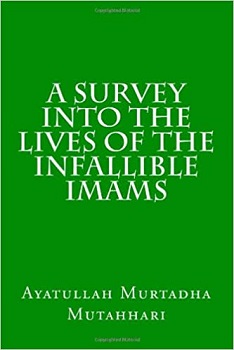A Survey into the Lives of the Infallible Imams
 | |
| Author | Murtadha Mutahhari |
|---|---|
| Language | English |
| Published | Second Edition, 2014 |
| Publisher | CreateSpace Independent Publishing Platform |
| Pages | 261 |
The book A Survey into the Lives of the Infallible Imams describes the expression of the manners of the pure Imams especially how they deal with the issue of the caliphate and the government.
About the author
Murtadha Mutahhari was a prominent Shi’a jurist, philosopher, theologian, thinker, and writer of the twentieth century. He was a student of Allamah Tabataba'i and Imam Khomeini and was considered to be one of the most influential contemporary Iranian clerics in expounding upon Islamic teachings, in keeping pace with the need of the time. He was one of the founders of Husayniyya-yi Irshad, a significant center for propagating Islamic teachings before the revolution. Elucidating Islamic beliefs and acting according to the need of the time were the characteristics of Motahhari's intellectual activities. Motahhari presented Islamic concepts that were earlier dealt with in a complicated manner in a simple and easy manner in his own personal style. His books on different topics have been repeatedly published in Persian and other languages. Motahhari is considered an influential person and an intellectual leader of the Islamic revolution of Iran.
About the book
This book written by Ayatullah Murtadha Mutahhari and translated into English by Zainab Muhammadi ‘Araghi was published in ABWA Publishing and Printing Center; First Edition (2010), Second Edition (2014). This 261-page book is a collection of lectures and discussions by Ayatullah Morteza Motahhari, which have been delivered at different times and places and provides a good analysis of the lives of the Infallible Imams while presenting the different methods, struggles, and circumstances of each Imam and how they may have acted similarly or differently.
Abstract of chapters
Chapter 1: ‘Ali’s Struggles
This chapter consists of a lecture entitled "Problems of Imam Ali". The first difficulty that presented itself was the assassination of Uthman, that in this regard Ali’s thoughts did not match those of the revolutionaries or of the rest of the people.
Chapter 2: Imam al-Hassan’s Pacifism (Session 1 & 2)
The second chapter is about pacifism. Some claim that Imam al-Hassan and Imam al- Hussain were two fundamentally different characters: Imam al-Hassan was more of a peace-seeker by nature, whereas Imam al-Hussain was a rebellious and warrior-like. The author believes that the issue of pacifism was not exclusive to Imam al-Hassan. The Prophet had also adopted conciliatory methods during the first few years of the prophetic mission until the end of his time in Mecca, and even during the second year after entering Medina.
Chapter 3: A Discourse on Imam Zayn al-‘Abidin
This chapter is dedicated to discussion about Imam Zayn al-‘Abidin (also known as ‘Ali ibn al-Hussain) who is described and viewed as the “champion of spirituality”. He was known as the herald of affection and his home was the house of the poor, the orphans and the helpless.
Chapter 4: Imam al-Sadiq and the Issue of Vicegerency (Session 1 & 2)
This chapter is about Imam al-Sadiq who encountered the issue of ruling and caliphate. The issue of Imam al-Sadiq’s retreat from accepting government and the caliphate was very clear and it is explained in this chapter. Imam al-Sadiq had spiritual and intellectual capacity. He had students in various spheres.
Chapter 5: The Reasons for Imam Musa al-Kazim’s Martyrdom
The topic of discussion in this chapter is about the martyrdom of Imam Musa ibn Ja‘far. According to the most famous and most valid narrations, Musa ibn Ja‘far spent four years in the corner of prison dungeons and passed away there. There are historical texts about the time the Imam spent in prison; suggestions were constantly forwarded to the Imam demanding for apology or even a verbal confession from him, but the Imam never agreed.
Chapter 6: The Issue of Imam al-Rida as the Crown Prince (Session 1 & 2)
This chapter’s topic is a historical debate and of the secondary issues related to Imamate (the leadership of Ahl al-Bayt) and caliphate. This issue is better known as Imam al-Rida “as the crown prince”. The author in this chapter analyzes the issue of succession, which is a very important historical issue.
Chapter 7: On the Topic of Imam al-Hassan al‘Askari
This chapter consists of a speech about Imam Hassan Askari. As it is known each of the holy Imams had a certain quality that was more apparent in them. The holy being of Imam al-‘Askari was distinguished by dignity and so-called good looks. The greatness and dignity reflecting on his face was in such a way that whoever visited him would get influenced by his appearance even before the Imam said a word. This story is fully specified in the majority of narrations. Even the enemies, who constantly pursued the Imam and were sometimes taking the Imam to prison, could not resist paying their respect towards him when confronting the Imam.
Chapter 8, Part 2: The Promised [Maw‘ud] al-Mahdi
The last chapter consists of two lectures about Hazrat Mahdi, the first of which is entitled "General Justice" and the second one is entitled "The Promised Mehdi"
The author in this chapter mentions two subjects. The first one is the main reasons for the sending of all divine prophets by God Almighty to humanity, and the second one is the issue of justice (that is the universal justice and common justice not the relative or individual justice)—by justice he means that there will come a day in this world for mankind when all traces of tyranny, oppression, discrimination, war, hatred, bloodshed or exploitation and their tools such as lies, hypocrisy and deception will ultimately be nonexistent.